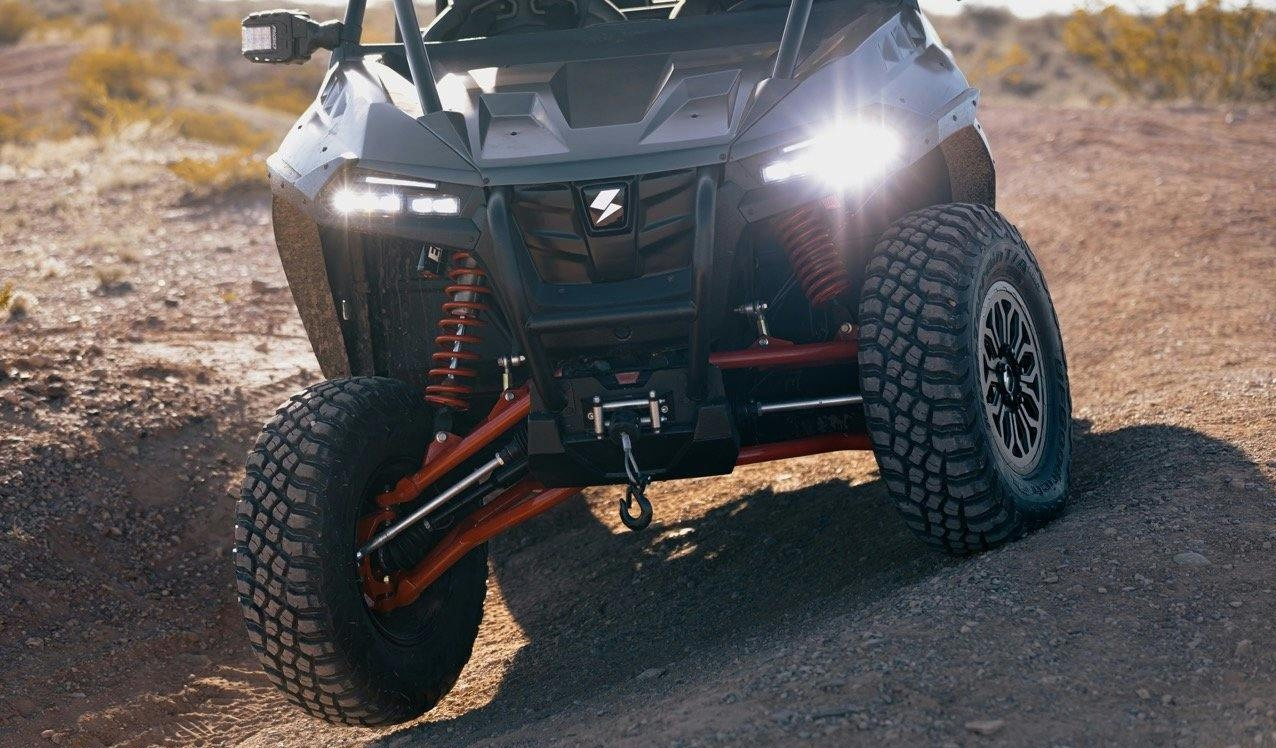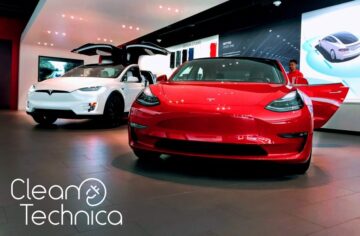
Sign up for daily news updates from CleanTechnica on email. Or follow us on Google News!
The US military’s long, slow ride into the electrified world of the future has shifted gears, now that the Army Corps of Engineers is in the driver’s seat. The USACE has set itself a goal of developing dual-use electric vehicles that can support both itself and the Army on disaster response missions, and they are getting an assist from off-road experts at the Texas-based EV startup Volcon.
Super-Sporty Electric Vehicles For Disaster Response
It’s fair to ask why the US Army Corps of Engineers gets to have super-sporty off-road electric vehicles and not just plain old workaday street-legal electric vehicles. Part of the answer lies in USACE’s responsibilities, which cover hundreds of construction projects, dams, waterways, and other facilities requiring off-road mobility.
USACE also has a long list of responsibilities to fill as one of the federal agencies called upon by the Federal Emergency Management Agency for federal disaster response. Though its core duties focus on infrastructure, USACE notes that it is often called upon for off-list tasks.
The Army has begun to take a serious look at vehicle electrification for front line work, but apparently the going has been too slow for USACE. Last fall, USACE entered its Construction Engineering Research Laboratory into a formal agreement with Volcon, launching a collaborative effort to develop duty-worthy electric vehicles for USACE and the Army (see our complete Volcon archive here).
Making Better Electric Vehicles For The US Army
Volcon has its work cut out for it. The company is tasked with lending its technology know-how to USACE, which aims to “improve energy management in electric vehicles, including measurement, monitoring, range extension, and export power processes and procedures.”
The Volcon–USACE collaboration is also expected to yield results that build on the Army’s pursuit of microgrids and electric vehicle-to-grid technology.
Developing “enhanced tactical ground vehicle applications” is officially part of the plan, which is interesting because it could lead to follow-on applications for the US Marine Corps.
Back in 2019, the US Army put out the call for automotive and defense stakeholders to develop a new Joint Light Tactical Vehicle for use by both the Army and Marine Corps. The goal was to modernize the tactical fleet, not electrify it, though several firms have teased the idea of an electric tactical vehicle.
Volcon’s contribution to an electrified tactical fleet appears to be limited to emergency response, but the Army’s requirements for its new JLTV provide some clues about the level of expectations for USACE’s new electric vehicles.
“The JLTV brings increased protection and performance to the fleet; minimizes ownership costs by maximizing commonality, fuel efficiency and reliability; and maintains effective competition throughout its life cycle,” the Army explains.
“Commonality of components, maintenance procedures, training, etc., between vehicles is expected to be inherent in Family of Vehicle solutions across mission variants to minimize total ownership cost,” the Army adds.
Next (Baby) Steps For USACE
Volcon has not been letting the grass grow under its feet. Last week, the company announced delivery of its first two production-level electric vehicles for the USACE program, under the rather somewhat loaded name of “Stag.”
The animal imagery is a bit of a departure for Volcon, which has already established itself as the maker of the electric Grunt, Runt, and Brat four- and two-wheelers. However, Stag does share the firm’s preference for short, evocative nomenclature, loaded or not.
As for those two new Stags, don’t break out the pom-poms just yet. Volcon is putting both vehicles through their paces at its headquarters in Round Rock, Texas. Once everything checks out, Volcon is sending one of them off to its dealer network for demonstration and educational duties.
That leaves just one for USACE to look over, which is kind of disappointing. However, that doesn’t mean USACE has been asleep on the EV job.
Last August, for example, the US Department of Energy noted that USACE has developed an online tool to help other federal agencies assess and prioritize locations for EV charging stations. The Energy Department lists “emissions, energy costs, access to public charging, and environmental justice concerns” among the factors.
“These factors help determine the projects that will have the greatest impact on achieving USACE’s goals, including a 100% transition to zero-emission vehicle (ZEV) acquisitions, reduction of facility emissions, and integration of environmental justice principles into planning,” the Energy Department notes.
… Make That Giant Steps For Electric Vehicles
Apparently, USACE is not letting the grass grow under its feet either. Last month the agency ordered dozens of off-grid EV charging stations for the Army Materiel Command from the company Beam Global, to the tune of $7.4 million.
“The systems will be deployed across 21 locations in 16 states,” according to Beam, including Materiel Command locations in Alabama, Arizona, California, Colorado, Indiana, Iowa, Kentucky, Missouri, New York, North Carolina, Oklahoma, Pennsylvania, Tennessee, Texas, Utah, and Virginia.
The total number of charging stations comes out to 88, which might not sound particularly ambitious as the US prepares for millions of electric vehicles to hit the road in the coming years. However, the Materiel Command is central to the Army’s intricate supply system, particularly when the task involves shedding outdated legacy systems and adopting new ones.
Lessons learned from EV charging stations at those locations could influence electric vehicle procurement throughout the Army, and beyond.
“As the Army’s Lead Materiel Integrator, Army Materiel Command manages the global supply chain, synchronizing logistics and sustainment activities across the Army,” AMC says of itself. “Army Materiel Command logisticians and sustainers are fully embedded within every Army modernization effort and initiative.”
“AMC is the lead for divesting legacy systems, freeing up space for new equipment, and for modernization of Army installations and strategic power projection capabilities worldwide,” they emphasize.
For the record, the Materiel Command locations are just part of a new USACE EV charging station acquisition for the Army. In addition to those 21 sites, USACE also awarded contracts for a total of 367 solar-powered charging stations for the US Army Installation Management Command, which organizes the day-to-day operations of garrison communities in the US and around the world.
Follow me @tinamcasey on Bluesky, Threads, Post, and LinkedIn.
Photo (cropped): the US Army Corps of Engineers will be putting electric vehicles from the Texas startup Volcon through their paces as part of its efforts to prep the military for a fleet electrification makeover.
Have a tip for CleanTechnica? Want to advertise? Want to suggest a guest for our CleanTech Talk podcast? Contact us here.
Latest CleanTechnica TV Video
[embedded content]
Advertisement
CleanTechnica uses affiliate links. See our policy here.
- SEO Powered Content & PR Distribution. Get Amplified Today.
- PlatoData.Network Vertical Generative Ai. Empower Yourself. Access Here.
- PlatoAiStream. Web3 Intelligence. Knowledge Amplified. Access Here.
- PlatoESG. Carbon, CleanTech, Energy, Environment, Solar, Waste Management. Access Here.
- PlatoHealth. Biotech and Clinical Trials Intelligence. Access Here.
- Source: https://cleantechnica.com/2024/03/02/us-military-eyeballs-super-sporty-electric-vehicles-for-all-terrain-duty/
- :has
- :is
- :not
- $UP
- 16
- 2019
- 21
- 4
- a
- About
- access
- According
- achieving
- acquisitions
- across
- activities
- addition
- Adds
- Adopting
- Advertise
- Affiliate
- agencies
- agency
- Agreement
- aims
- Alabama
- All
- already
- also
- ambitious
- AMC
- among
- an
- and
- animal
- announced
- answer
- appears
- applications
- Archive
- ARE
- arizona
- Army
- around
- AS
- ask
- assess
- assist
- At
- AUGUST
- automotive
- awarded
- Baby
- BE
- Beam
- because
- been
- begun
- Better
- between
- Beyond
- Bit
- bluesky
- both
- Break
- break out
- Brings
- build
- but
- by
- california
- call
- called
- CAN
- capabilities
- Carolina
- central
- chain
- charging
- charging stations
- Checks
- cleantech
- Cleantech Talk
- collaboration
- collaborative
- Colorado
- comes
- coming
- coming years
- Communities
- company
- competition
- complete
- components
- construction
- content
- contracts
- contribution
- Core
- corps
- Cost
- Costs
- could
- cover
- Cut
- cycle
- day-to-day
- dealer
- Defense
- delivery
- Department
- Department of Energy
- deployed
- Determine
- develop
- developed
- developing
- disappointing
- disaster
- does
- Doesn’t
- Dont
- dozens
- educational
- Effective
- efficiency
- effort
- efforts
- either
- Electric
- electric vehicle
- electric vehicles
- electrification
- electrify
- embedded
- emergency
- Emissions
- emphasize
- energy
- Engineering
- Engineers
- entered
- environmental
- equipment
- established
- etc
- EV
- everything
- example
- expectations
- expected
- experts
- Explains
- export
- extension
- Eyes
- facilities
- Facility
- factors
- fair
- Fall
- family
- Federal
- Feet
- fill
- firms
- First
- FLEET
- Focus
- For
- formal
- freeing
- from
- front
- Fuel
- fuel efficiency
- fully
- future
- gears
- gets
- getting
- giant
- Global
- goal
- Goals
- going
- grass
- greatest
- Ground
- Grow
- Guest
- Have
- Headquarters
- help
- Hit
- However
- HTML
- HTTPS
- Hundreds
- idea
- Impact
- in
- Including
- increased
- Indiana
- influence
- Infrastructure
- inherent
- Initiative
- installation
- integration
- interesting
- into
- intricate
- involves
- Iowa
- IT
- ITS
- itself
- Job
- jpg
- just
- just one
- Justice
- Kentucky
- Kind
- laboratory
- Last
- launching
- lead
- learned
- leaves
- Legacy
- lending
- letting
- Level
- lies
- Life
- light
- Limited
- Line
- links
- List
- Lists
- locations
- logistics
- Long
- Look
- maintains
- maintenance
- make
- maker
- management
- manages
- Marine
- maximizing
- me
- mean
- measurement
- might
- Military
- million
- millions
- minimize
- minimizes
- Mission
- missions
- mobility
- modernization
- modernize
- monitoring
- Month
- name
- network
- New
- New York
- news
- North
- north carolina
- noted
- Notes
- now
- number
- of
- off
- Officially
- often
- Oklahoma
- Old
- on
- once
- ONE
- ones
- online
- Operations
- or
- organizes
- Other
- our
- out
- outdated
- over
- ownership
- part
- particularly
- Pennsylvania
- performance
- Plain
- plan
- planning
- plato
- Plato Data Intelligence
- PlatoData
- player
- podcast
- policy
- Post
- power
- Prepares
- principles
- Prioritize
- procedures
- processes
- procurement
- Program
- Projection
- projects
- protection
- provide
- public
- pursuit
- put
- Putting
- range
- rather
- record
- reduction
- reliability
- Requirements
- research
- response
- responsibilities
- Results
- Ride
- road
- Rock
- round
- says
- see
- sending
- serious
- set
- several
- Share
- shedding
- shifted
- Short
- Sites
- slow
- solar-powered
- Solutions
- some
- somewhat
- Sound
- Space
- stakeholders
- startup
- States
- station
- Stations
- Steps
- Strategic
- suggest
- supply
- supply chain
- support
- system
- Systems
- tactical
- Take
- Talk
- Task
- tasked
- tasks
- teased
- Technology
- tennessee
- terrain
- texas
- that
- The
- The Future
- The Projects
- the world
- their
- Them
- they
- those
- though?
- Through
- throughout
- tip
- to
- too
- tool
- Total
- Training
- transition
- tune
- tv
- two
- under
- Updates
- upon
- us
- us army
- US military
- use
- uses
- utah
- variants
- vehicle
- Vehicles
- Video
- virginia
- want
- was
- week
- when
- which
- why
- will
- with
- within
- Work
- world
- worldwide
- years
- yet
- Yield
- york
- youtube
- zephyrnet







